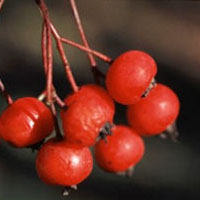
A-Z Indexes Food Health Guides
Health News |
HawthornFind ProductsAlso indexed as:Crataegus laevigata, Crataegus monogyna, Crataegus oxyacantha  © Steven Foster © Steven FosterBotanical names: Crataegus laevigata, Crataegus monogyna, Crataegus oxyacanthaHow It WorksThe leaves, flowers, and berries of hawthorn contain a variety of bioflavonoids that appear to be primarily responsible for the cardiac actions of the plant. Flavonoids found in hawthorn include oligomeric procyanidins (OPCs), vitexin, vitexin 4’-O-rhamnoside, quercetin, and hyperoside. These compounds are often standardized in leaf and flower extracts, which are widely used in Europe. Hawthorn is thought to exert many beneficial effects on the heart and blood vessels. These include improved coronary artery blood flow and strengthening of the contractions of the heart muscle.1 Hawthorn may also improve circulation to the extremities by lowering the resistance to blood flow in peripheral blood vessels.2 The bioflavonoids in hawthorn are potent antioxidants.3 Hawthorn extracts may mildly lower blood pressure in some people with high blood pressure but should not be thought of as a substitute for cardiac medications for this condition. Clinical trials have confirmed that hawthorn leaf and flower extracts are beneficial for people with stage II (early-stage) congestive heart failure.4, 5, 6, 7, 8 People with congestive heart failure taking 160–900 mg of hawthorn extract per day for eight weeks showed improved quality of life including greater ability to exercise without shortness of breath and exhaustion. Congestive heart failure is a serious medical condition that requires expert management rather than self-treatment. One study has shown that hawthorn leaf and flower extract may also help those with stable angina.9 How to Use ItExtracts of the leaves and flowers are most commonly used in modern herbal medicine. Hawthorn extracts standardized for total bioflavonoid content (usually 2.2%) or oligomeric procyanidins (usually 18.75%) are often suggested. Many doctors recommend 80–300 mg of the herbal extract in capsules or tablets two to three times per day.10 If traditional berry preparations are used, the recommendation is at least 4–5 grams per day or a tincture of 4–5 ml three times daily. However, this form has not been clinically studied. Hawthorn is slow acting and may take one to two months for maximum effects to be seen. However, it appears to be safe and should be considered a long-term therapy. Copyright © 2025 TraceGains, Inc. All rights reserved. Learn more about TraceGains, the company. The information presented by TraceGains is for informational purposes only. It is based on scientific studies (human, animal, or in vitro), clinical experience, or traditional usage as cited in each article. The results reported may not necessarily occur in all individuals. Self-treatment is not recommended for life-threatening conditions that require medical treatment under a doctor's care. For many of the conditions discussed, treatment with prescription or over the counter medication is also available. Consult your doctor, practitioner, and/or pharmacist for any health problem and before using any supplements or before making any changes in prescribed medications. Information expires December 2025. |
